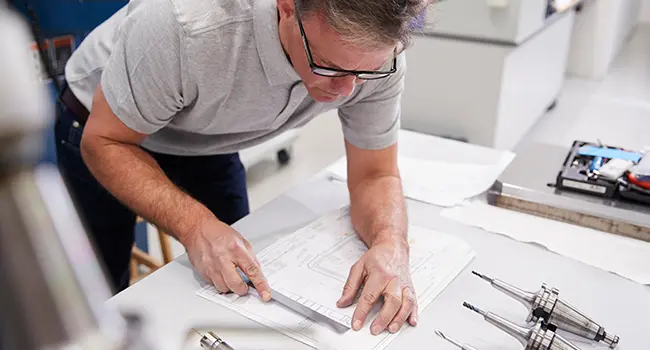
What Is an Engineering Change Order?
Blog Article | March 26, 2023
This article defines Engineering Change Order (ECO), its purpose, and the key stages of the process.
An Engineering Change Order (ECO) is a document that defines changes to an existing “released” CAD model or drawing, or otherwise certified type design. It is typically used in new product development and sustaining engineering but can also be used to repair faulty products. Engineering Change Orders undergo analysis and consideration from engineering, manufacturing, quality, procurement, configuration control, and project management before approval is given to make changes to existing released design data. The CCB or “Change Control Board”, which consists of all key stakeholders, (i.e., engineers, quality control, procurement, and project management), approves or rejects the ECO. For an ECO to be approved, all members of the CCB must approve. How can your company benefit from ECOs? Read below to find out.
The Difference Between an ECO and an ECR in Engineering
ECO? ECR? So many acronyms… so little time. Don’t worry; our job here at Saratech is to make things easier for you. Here is a simple breakdown of these acronyms:
ECO: Engineering Change Order
A document that lists all the proposed changes to a current released product. Approval by the CCB (Change Control Board) is required to implement these changes. An engineering change order is more detailed than an engineering change request and is only created once an engineering change request is approved.
ECR: Engineering Change Request
An engineering change request is a document that precedes an engineering change order. Once the appropriate team members approve it, an engineering change order is created. An engineering change request describes the origins of an issue and discusses ways to fix it, unlike an engineering change order which highlights what changes are being made.
The Purpose and Benefits of an Engineering Change Order
Engineering change orders serve many purposes. For one, they are the industry-standard method of tracking any changes made to the released design data. Proper documentation of modifications made within the company can help prevent confusion, product improvement delays, and costly mistakes. For example, let’s say the Acme company is making a part; let’s call this “Part B.” On “Part B,” there is a little notch that connects the part to “part C.” One day an engineer at the Acme company realizes that the notch on “Part B” doesn’t quite fit into “Part C,” causing a safety issue that needs to be fixed. Suppose the engineer does not notify the proper departments of the change in design; this failure to notify other departments may result in incorrect parts being manufactured. This would ultimately lead to product waste and a delay in production. If the engineer had realized this mistake and started creating an engineering change order, all of the proper departments and stakeholders would know about the change. The change could then be implemented, avoiding costly mistakes. An engineering change order’s purpose is to document issues and resolutions as they come, inform all of the proper stakeholders, create an easy way to approve or reject changes, and finally, create an easy way to implement changes in a company without miscommunication errors.

What to Include in an Engineering Change Order
A good engineering change order has many moving parts. Engineering change orders must be as thorough as possible to avoid confusion and delays. A good engineering change order contains information about the issue at hand, how the issue is going to be solved, and an analysis of the issue. It also includes the product life cycle roles that will be impacted by the change and the departments involved in implementing it. It is essential to be as detailed as possible when writing an engineering change order. This ensures that all parties are entirely aware of the change and how it affects them and their work. An engineering change order must also be approved by the CCB, so it is important to include how each individual team is impacted by the change. Specifics are necessary and broad terms such as “around”, “about”, and “approximately” should be avoided when drafting an engineering change order.
Critical Stages of the Engineering Change Order Process
There are typically seven stages to the Engineering Change Order Process.
Stage 1: Issue Identification and Scoping
Stage 2: ECR Creation
Stage 3: ECR Review: Approval or Rejection
Stage 4: ECO Creation
Stage 5: ECO Review: Approval or Rejection
Stage 6: Approval or Rejection Notification
Stage 7: Change Implementation (if approved)
The first stage in an engineering change order is issue identification and scoping. In this stage, someone on the team identifies an issue. The issue’s scope and details are then evaluated to create a viable solution. The next stage in an engineering change order is the creation of the ECR. This document comes before the engineering change order and discusses the problem and what it will take to solve it. The next stage is the ECR review. Once the ECR is reviewed and approved, the ECO is created. Unlike the engineering change request, which highlights what changes should be made, the ECO highlights how these changes will be made, and what departments and people will be affected by the change(s). Once the ECO is created, it goes through a rigorous approval process, passing through the hands of engineers, managers, and other stakeholders. If the ECO review is approved, the sixth stage, approval notification, is given to the team. Once the team receives approval, the last and final stage of the engineering change order begins. The last stage is called “Change Implementation”. This is when the actual change begins to take effect. As one can see, there are many stages to an engineering change order. It is important for teams to follow the stages thoroughly and with care because any misstep can be costly for the company.

What an Engineering Change Order Means in Manufacturing and Product Lifecycle Management (PLM)
An engineering change order in manufacturing can mean many different things. Some engineering change orders are created to improve a design. At one or multiple points in a product’s lifecycle, improving its design might be requested. Program management must then consider if implementing the design change will have a positive effect on the product and for the company. Managers may wonder, “What is the opportunity cost for improving?” If the product is already in the manufacturing stage, companies will often decide not to make a small improvement because it becomes very costly to make the change. In some instances, however, the company will not have a choice in deciding to reject a change in design if it is a crucial repair. Other engineering change orders are created to initiate repairs. Unlike improvements, repairs not only optimize a design but ensure a product will function properly. A product that creates an unreasonable safety risk or fails to meet minimum safety standards is an example of when not issuing a repair becomes a liability for the company. Even if the repair is costly and harms the company’s revenue, project management must give an ECO if the product is unsafe for customers. Upon realizing a defect in design, managers might issue a line stop, which halts all manufacturing until the engineering change order (ECO) is received. An engineering change order is an integral part of a company’s manufacturing and product life cycle management processes.
Common Mistakes to Avoid When Creating an Engineering Change Order
One of the most common mistakes that occurs when creating an ECO is not fully documenting all changes that have been made. It is important to document every single change, no matter how small it is, to ensure that there is always a way to look back at the changes and determine which, if any, changes caused an issue. Ideally, this will include a thorough RCCA (root cause and corrective action) and may consist of a “Fishbone” or “Five-why” worksheet. Imagine a block of code that works well enough but needs to be edited to create a more streamlined experience. If someone came in and changed multiple lines of code without documenting what they did, they would not be able to pinpoint an item that may have broken the code. If someone were to take this same block of code and change things line by line, they would be able to identify what caused the code to break and where it went wrong. This is the same idea when it comes to physical products. When documenting change processes, it is easy and tempting to skip a few things here and there. Some changes may seem like “common sense.” However, the biggest mistake when creating an engineering change order is not comprehensively documenting every change and its effect on key stakeholders. Being as thorough as possible when making an engineering change order can help prevent miscommunication and errors in the future. Another common mistake when creating engineering change orders is too much documentation. It is important to highlight what is being changed, and how that change affects the stakeholders. Adding too much information can create confusion, more mistakes, and a longer review process. Another common mistake is neglecting to include all groups that may be affected by the change proposed in the ECO. All groups affected by the proposed change or changes must be included in the process. Not only is it important to send the ECO to the proper groups, it is also important to send the documents at the right time. Sometimes groups and stakeholders are affected by later stages of the ECO, so it is imperative that documentation gets sent to the right groups at the right time to increase efficiency and help reduce delays in the process.
Conclusion
Companies must be ready to respond to shifts in consumer preferences, as well as possible unforeseen safety risks that require immediate product design changes. An engineering change order (ECO) is a critical part of keeping product development on track and ensuring the best possible outcome. By listing the full description, analysis, and impact of a change, an ECO makes it clear to all stakeholders why a change is necessary. An organized method of handling product changes reduces potential design, manufacturing, and inventory errors and minimizes development delays. Following good ECO practices also makes it easy to document a complete history of the changes made to a product and when they occurred. Keeping a record of product changes will help you solve problems after your product launches.


